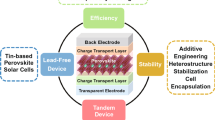Abstract
Solar energy harvesting has been extensively studied in the last three decades to provide a green energy source. Hybrid photovoltaics (HPV) based on titania (TiO2) are researched for their easiness of production and low cost. Nanostructured mesoporous titania films and conductive polymers were used recently to form hybrid solar cells [1]. TiO2, mainly an n-type semiconductor with a band gap of 4.2 eV, is employed in several applications from which paints form the highest world use of titania making it an attractive material to use in HPV industry. On the other side, our targeted conductive polymer is polyaniline (PANI), a hole conductor polymer, which is used in such HPV cells due to its high charge-carriers mobility, absorption coefficient in the visible range and environmental stability. PANI and nanocrystalline TiO2 films fabricated using spin coating or layer by layer assembly techniques behave as a p-n heterojunction diode and can be used as solar cells [2-4].
Precursor solutions are prepared by polymerizing aniline-HCl inside an aqueous solution of titania. To study the effect of the precursor concentration on the PANI-TiO2 composite, polymerization of aniline is held in diverse TiO2 concentrations in water. Industrial grade TiO2 powders with particle size ranging from 200 nm to several μm are used. PANI-TiO2 precursor solutions are dip coated or slot dyed on various substrates such as PMMA, PET and PP, all with metal oxide conductive coatings. Bulk PANI-TiO2 pellets are prepared for comparison. The electrical and photovoltaic properties of the obtained films and pellets are investigated to choose the optimum blend composition for HPV cell. Finally a theoretical study and an analytical model of the HPV cell are presented relating the size of TiO2 and PANI particles and their respective geometrical distribution inside the blend to the transport characteristics of charge carriers and the overall efficiency of the HPV cell.[1] M. McGehee, MRS Bulletin, Vol. 34, No. 2, February 2009.[2] Z. Liu, W. Guo, D. Fu and W. Chen, Synthetic Metals, Vol. 156, pp. 414–416, 2006.[3] Z. Liu, J. Zhou, H. Xue, L. Shen, H. Zang and W. Chen, Synthetic Metals, Vol. 156, pp. 721–723, 2006.[4] X. Zhang, G. Yan, H. Ding and Y. Shan, Materials Chemistry and Physics, Vol. 102, pp. 249–254, 2007.
Similar content being viewed by others
References
B. O’Regan and M. Grätzel, Nature 353, 737 (1991).
L. Yang, Y. Lin, J. Jia, X. Li, X. Xiao and X. Xhou, Micropor. Mesopor. Mat. 112, 45 (2008).
Y. Yoshioka, M. Tsujimoto, M Koshino, T. Nemoto, T. Ogawa, H. Kurata and S. Isoda, Mol. Cryst. Liq. Cryst. 424, 95 (2004).
Z. Liu, J. Zhou, H. Xue, L. Shen, H. Zang and W. Chen, Synthetic Met. 156, 721 (2006).
Z. Liu, W. Guo, D. Fu and W. Chen, Synthetic Met. 156, 414 (2006).
M. McGehee, MRS Bulletin 34, February 2009.
Y. Li, J. Hagen and D. Haarer, Synthetic Met. 94, 273 (1998).
S. Tan, J. Zhai, M. Wan, L. Jiang and D. Zhu, Synthetic Met. 137, 1511 (2003).
S. Radhakrishnan, C. Siju, D. Mahanta, S. Patil and G. Madras, Electrochim. Acta 54, 1249 (2009).
A. Fujishima and K. Honda, Nature 238, 37 (1972).
X. Li, D. Wang, G. Cheng, Q. Luo, J. An and Y. Wang, Appl. Catal. B. 81, 267 (2008).
J. Stejskal and R. G. Gilbert, Pure Appl. Chem. 74, 857 (2002).
F. Cataldo and P. Maltese, Polym. Advan. Technol. 12, 293 (2001).
B. Kim, K. Lee, P. Huh, D. Lee, N. Jo and J. Lee, Synthetic Met. 159, 1369 (2009).
J. Xu, W. Liu and H. Li, Mat. Sci. Eng. C 25, 444 (2005).
Hanawalt et al., Anal. Chem. 10, 474 (1938).
E. Kang, K. Neoh and K. Tan, Prog. Polym. Sci. 23, 277 (1998).
Author information
Authors and Affiliations
Corresponding author
Rights and permissions
About this article
Cite this article
Michael, I.I., Maria, J.B., Umit, B.D. et al. Photovoltaic Properties of Polyaniline-Titania Composite for Hybrid Solar Cells Applications. MRS Online Proceedings Library 1211, 318 (2009). https://doi.org/10.1557/PROC-1211-R03-18
Received:
Accepted:
Published:
DOI: https://doi.org/10.1557/PROC-1211-R03-18




